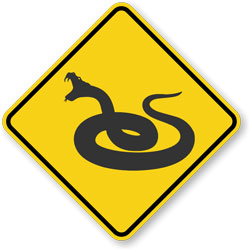

I was reading an article in the Monday Wall Street Journal that discussed some of the reasons for France’s success thus far in the 2022 World Cup, and the following excerpt piqued my curiosity:

Wonder how much the writer actually knows about copperheads?
Attacks like a copperhead. What an odd choice of simile. I mean, sure, a snake strike is quick, but why did the author pick a copperhead as a symbol of lightning lethality?
Alert Gazette readers know that I can’t resist going on a snake hunt — especially when it’s done virtually and the only danger to me is the possibility of eyestrain and RMS. So I decided to do the sort of in-depth research and hard-hitting reporting that I’ve deceived myself into thinking that I do, and I googled up a few websites that purport to list the fastest striking snakes in the world. And while I was at it — because “thoroughness” was almost my middle name — I also asked Mr. Google for some links regarding the fastest running snakes. I’m pretty sure snakes don’t have legs, so let’s put “running” in quotes, shall we?
Let’s address the latter question first: what are the fastest snakes on the ground? (Heaven forbid we have to deal with snakes in the air, and someone else has already covered Snakes On A Plane.) The answers may surprise you; they did me, anyway.
According to these two websites, the fastest moving snake is the sidewinder (Crotalus cerastes), aka horned rattlesnake. Despite its weird style of locomotion, this scaly dude can reach a speed of 18 mph. If you’re a runner, that converts to 3.33 minutes/mile, faster than any human on record. Now, given that it’s highly unlikely that a snake could maintain that speed for an entire mile, a better comparison might be with the world record for the 100 meter dash. Usain Bolt’s 9.58 seconds converts to a fairly incredible speed of 23.35 mph, making him pretty safe from the predations of a sidewinder. You and I should not feel so secure.
In second and third places, we find the highly venomous (just ask Budd from Kill Bill: Vol. 2) black mamba (Dendroaspis polylepis) at ~12 mph, and the non-venomous southern black racer (Coluber constrictor priapus) at ~10 mph.
Now, lest you’re thinking, well, I’m a swimmer, not a runner, so I’m in no danger, allow me to further dampen your watery enthusiasm. The yellow-bellied sea snake (Hydrophis platurus), another highly venomous serpent and the only sea snake to have reached the Hawaiian Islands, can swim at speeds up to two miles per hour. Michael Phelps has been clocked at 5-6 mph, so he’s golden.
In summary, it’s safe to say that the French football team is capable of outrunning the fastest snakes on the planet. But what about that whole striking thing?
There seems to be some contradictory discussions about the fastest striking snakes and I could find only one documented controlled experiment that assessed this behavior. However, there does seem to be some agreement about the top three fastest snakes in North America, so let’s focus on them.
But first, it’s helpful, or at least interesting, to provide some context for the speed at which snakes can strike. Because many snakes feed on fast-moving prey, such as rabbits, lizards, mice, etc. it’s logical that striking speed is important for their survival. A snake strike can be as fast as 50 milliseconds, four times faster than a human eye blink. In addition, the force of acceleration brought to bear on a snake’s head during a strike can approach 30 Gs; even the best-trained humans would black out well before reaching those forces.
While there’s a tiny bit of disagreement about the order of the three fastest striking snakes in North America, there’s general consensus that they are the venomous northern cottonmouth (Agkistrodon piscivorus), the venomous diamondback rattlesnake (Crotalus atrox) and the non-venomous Texas or western rat snake (Pantherophis obsoletus). By the way, all three of these species are found within the city limits of the town where I live, and two of them, the cottonmouth and the rat snake, have been found on our block.
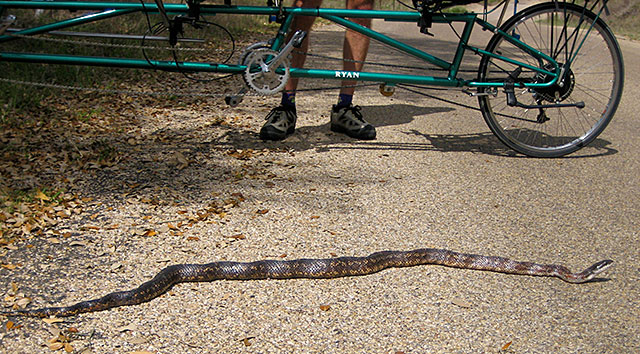
During a bike ride, we encountered this rat snake sunning itself on the road. It didn’t seem very fast.
Now, most of the articles I found dealing with striking speed didn’t cite their sources, and there were discrepancies regarding the precise measurements of the speeds, but as I mentioned above, there is at least one controlled experiment that measured the speeds of the aforementioned species.
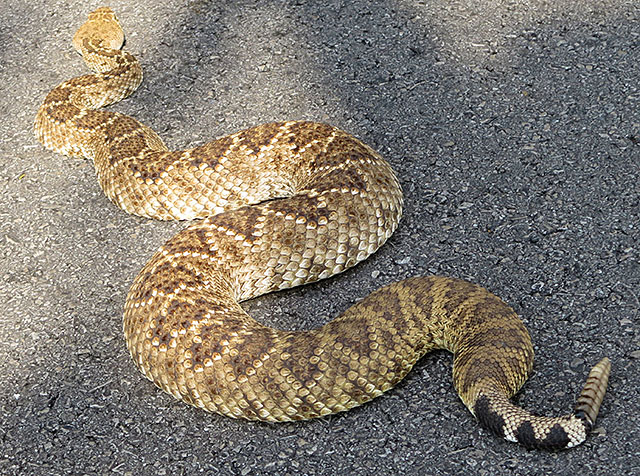
What is it with snakes and streets? Here’s a western diamondback rattlesnake.
In 2016, David Penning at the University of Louisiana (Lafayette) measured the striking speeds of those three species and found that within the population he tested, here’s how they matched up: (1) rat snakes – 190 meters/second squared, or 19 Gs; (2) cottonmouths – 173 meters/second squared; (3) rattlesnakes – 169 meters/second squared. (Out of fairness to the rattlers, the fastest snake in the test was a diamondback, which struck at a force equivalent to 28 Gs, but an individual rat snake wasn’t far behind, at 27 Gs.)
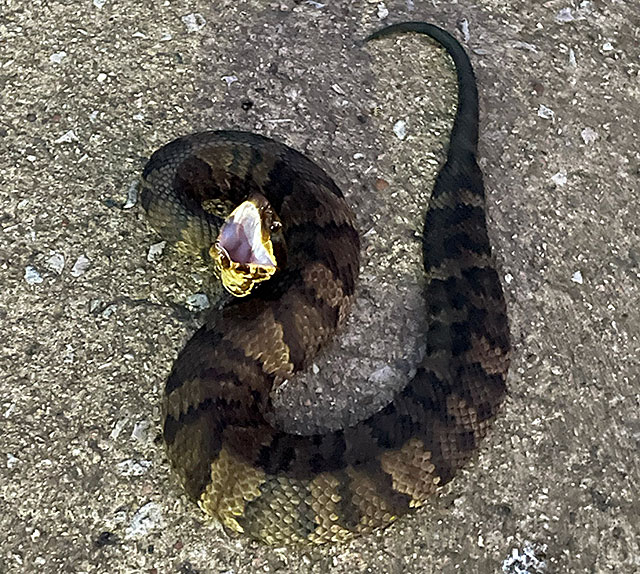
This cottonmouth was warning us away with its gaping mouth.
Of course, the capabilities of snakes in captivity might vary somewhat from those in the wild, but the overarching lesson is the same: you’re NOT going to evade a snake strike, or catch one in mid-strike, no matter how much you study a specific Jean-Claude Van Damme movie.
Outside of North America, the general consensus is that the incredibly venomous Gaboon viper (Bitis gabonica), a native of Africa, is the fastest striker in the world. It also has the longest fangs of any snake, in case you were wondering…and I’m sure you were or you wouldn’t have read this far.
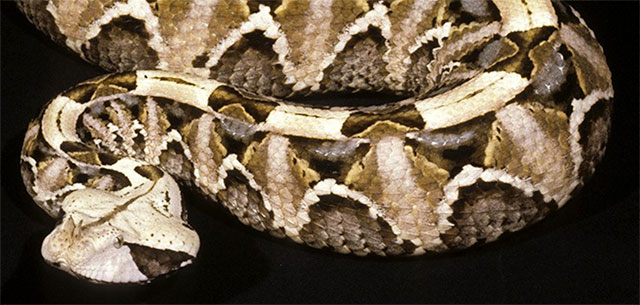
Gaboon viper
In case you’ve forgotten — I almost did — the thing that kicked off this whole discussion was the quote about the copperhead. And while this species didn’t appear on any lists of the fastest striking snakes, the fact that it’s an “ambush predator” and its prey is similar to that of rattlesnakes and cottonmouths (although it has a reputation for craving cicadas), it’s safe to assume that its strike speed is in the same ballpark.
What I’ve not been able to research is the reference to a “slow coil.” There seems to be dearth of people interested in the coil speed of snakes, and that’s really a shame. For now, anyway, I’m going to give the writer of the soccer article the benefit of the doubt, and a passing grade for an apt simile.
Discover more from The Fire Ant Gazette
Subscribe to get the latest posts sent to your email.


Now we need something about kittens or puppies.
What, like recipes or something? 🤣
You don’t have to outrun the snake, just whoever your with!
Rick, the problem with that approach is that now that you’ve gone on record, nobody is going anywhere with you. 😂